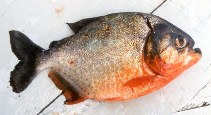| Family: |
Serrasalmidae (Piranhas and pacus), subfamily: Serrasalminae |
| Max. size: |
50 cm SL (male/unsexed); max.weight: 3,850.0 g |
| Environment: |
pelagic; freshwater; pH range: 5.5 - 7.5; dH range: 20 |
| Distribution: |
South America: Amazon River basin, Paraguay-Paraná River basin, northeastern Brazilian coastal rivers and Essequibo River basin (Ref. 39031). Reported from the Uruguay River, Brazil (Ref. 79585). |
| Diagnosis: |
Dorsal spines (total): 0-0; Dorsal soft rays (total): 16-18; Anal spines: 0-0; Anal soft rays: 27-30 |
| Biology: |
Common in creeks and interconnected ponds in Matto Grosso, Brazil, where it influences distribution and feeding of other fish (Ref. 9080) and in areas of high primary production in Rio Machado and Rio Negro (Ref.9096). Adults feed mainly at dusk and dawn. Feeds on insects, worms and fish (Ref. 7020). Medium-sized to large individuals (15-24 cm length) forage mainly at dawn, late afternoon and night up to about 2200H, whereas smaller fish (8-11 cm) are active mainly during the day (Ref. 9080). Teeth replacement on alternating sides of jaw allows continuous feeding. Its powerful dentition can inflict serious bites. Has a highly evolved auditory capacity and a 'lurking', then 'dashing' behavior during daytime. Shows hierarchies within small schools (Ref. 9077). Available information on body composition of 'piranha caju' flesh is 8.2% fat, 15.0% protein and 4.4% ash (Ref. 9251). |
| IUCN Red List Status: |
Not Evaluated (N.E.) Ref. (130435)
|
| Threat to humans: |
traumatogenic |
Source and more info: www.fishbase.org. For personal, classroom, and other internal use only. Not for publication.
